A guide to modules that could have a major impact on metro and enterprise networks * What they are * Who makes them * Why they’re hot
August 21, 2002

One of the key reasons that Ethernet has had such phenomenal success in enterprise networks is that vendors have gotten behind standards, and as a result, they’ve managed to drive up volumes while driving down costs. Thus, everybody -- users, system vendors, and component makers -- have wound up getting a great deal.Efforts to repeat this success at the next notch up in Ethernet speed (10 Gbit/s) are now under way, with the prospects of this technology having a big impact on telecom as well as enterprise networks. This is evident from high level of activity among developers of 10-Gbit/s Ethernet transponders, or "modules" as they’re often called. These developers have been thrashing out a collection of multi-source agreements covering different applications, and they’re beginning to ship products meeting some of these specs.The time has come, in other words, to come to grips with this latest development in transmission technology. This report aims to provide a starting point by setting the scene and identifying key transponder trends, reviewing requirements for 10G Ethernet transponders, and examining the major multi-source agreements. It also presents a table of vendors and products in the market.Here's a hyperlinked summary of the report:
What is a Transponder?
10-Gig Ethernet Transponders
SFI-4 Based MSAs
Xenpak MSA
Other XAUI-Based MSAs
XFP MSA
10-GigE Transponder MSA Summary
10-GigE Transponder Vendors
Product Table
A preview of this report, in the form of an online presentation by the author, Simon Stanley, Principal Consultant at Earlswood Marketing Ltd., can be downloaded free of charge from Light Reading’s Webinar archive.
— Introduction by Peter Heywood, Founding Editor, Light Reading
http://www.lightreading.com
A transponder is a module that contains both an optical transmitter and receiver and a multiplexer that changes the line rate. So for example, a transponder may receive a single 10.3-Gbit/s optical stream and multiplex that onto sixteen 644-Mbit/s streams.Transponders can be used in any networking system where an optical fiber is terminated and the data received is converted into an electrical signal. Transponders are used in 1-Gig and 10-Gig Ethernet systems as well as ATM, Sonet/SDH, and Fibre Channel for storage networks.A transponder integrates more than just the optical transmitter and receiver. A 10-Gig Ethernet transponder will include the multiplexer and data interface to the physical layer device, as well as a management interface. The management interface is used to configure the transponder; it can also be used to obtain information about the capabilities of the transponder and to initiate diagnostic tests.A 10-Gig Ethernet transponder may also include some or all of the physical layer functions, including Sonet framer and possibly an Ethernet MAC (media access control) layer.Most transponders are designed to meet the specifications referred to by a multi-source agreement (MSA). An MSA is a specification agreed to by two or more vendors. These are typically driven by a small number of founders, and as the specification develops and gains acceptance in the industry, it may be signed by 40 or more companies.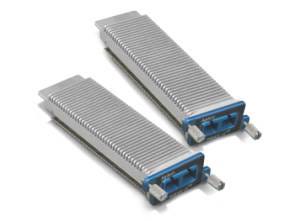
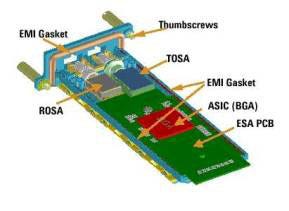 Figure 1 shows a typical transponder. This is a Xenpak transponder that is designed to be plugged in through the front panel of a typical piece of equipment. The back of the transponder plugs into a connector mounted on the system circuit board and is secured using the screws at the front.The transponder contains a small circuit board, comprising an optical receiver and transmitter with optical connectors and a small semiconductor device, which decodes the 10-Gbit/s serial stream to and from the transmitter and receiver and interfaces to the physical layer device on the system board. There is an EMI (electromagnetic interference) gasket to reduce emissions to acceptable levels.For each networking technology, transponder developments follow a similar path: Initial products are proprietary and include basic functionality; companies then work together to define basic MSAs, allowing interoperability between components from different vendors. For 10-Gig Ethernet, the first transponders were telecom modules with some additional functionality.Follow-on devices and further MSAs include additional features, as well as improving performance. For example, later MSAs:
Figure 1 shows a typical transponder. This is a Xenpak transponder that is designed to be plugged in through the front panel of a typical piece of equipment. The back of the transponder plugs into a connector mounted on the system circuit board and is secured using the screws at the front.The transponder contains a small circuit board, comprising an optical receiver and transmitter with optical connectors and a small semiconductor device, which decodes the 10-Gbit/s serial stream to and from the transmitter and receiver and interfaces to the physical layer device on the system board. There is an EMI (electromagnetic interference) gasket to reduce emissions to acceptable levels.For each networking technology, transponder developments follow a similar path: Initial products are proprietary and include basic functionality; companies then work together to define basic MSAs, allowing interoperability between components from different vendors. For 10-Gig Ethernet, the first transponders were telecom modules with some additional functionality.Follow-on devices and further MSAs include additional features, as well as improving performance. For example, later MSAs:
Extend reach to 80km or more
Increase integration
Support serial interfaces
Reduce power and cost
Include advanced management features
Specifically developed for Ethernet, newer transponders are "hot pluggable" -- in other words, they can be added or removed from equipment while it continues operating. By using hot-pluggable transponders, equipment manufacturers can supply systems with support for large number of ports but with only a few populated. With 10-Gig transponders costing between $1,000 and $15,000 apiece, this dramatically reduces the initial system cost but still allows the user to connect additional ports without switching off the system.A transponder includes several key components:An optical transmitter: To achieve good performance, these require a high output and low power. Most 1310nm lasers are uncooled, with 1550nm lasers requiring cooling. There is significant effort to extend the range of 1310nm transponders to 40km and of 1550nm lasers to 120km and beyond.An optical receiver: These need to have good sensitivity and noise immunity. Most receivers will handle wavelengths between 1100nm and 1600nm.Digital components:These support the required electrical interface to PHY and support multiplexing as well as management and diagnostic features. Some transponders include the 10-Gig Ethernet PCS layer and, in a few cases, the full physical layer and MAC.The transponder case: This is closely defined in later MSAs. The design of the case is key to good EMI and thermal performance.Transponder companies usually manufacture at least one of these components, and some make most of the components in-house. Many companies rely on their technology development in these components to stay ahead of their competition.Many MSAs reference specifications from International Telecommunication Union (ITU), Telcordia Technologies Inc., Institute of Electrical and Electronics Engineers Inc. (IEEE) or Optical Internetworking Forum (OIF) for some or most of the parameters. Some parameters may be typical, most are minimum or maximum. All transponder MSAs define the following parameters:
Optical Performance: Distance, loss, wavelength, receive sensitivity
Environmental: Case temperature, EMI, reliability
Data Interfaces: Type, width, speed, protocol
Management interface: Type, width, speed, protocol
Physical Dimensions: Footprint, electrical and optical connectorsNext page: 10-Gig Ethernet TranspondersThere are many drivers for 10-Gigabit Ethernet. In the local area network (LAN), there is a huge increase in bandwidth for enterprise backbones. Fast Ethernet at 100 Mbit/s is widely deployed, and there are an increasing number of 1-Gbit/s Ethernet nodes.In the wide area network (WAN), Fast Ethernet and Gigabit Ethernet are growing in the access network and metro edge, and there is a significant deployment of broadband through DSL and cable networks.There are huge bandwidths required between service provider points of presence (POP), and many operators are looking for cheaper alternatives to Sonet-based networks. In the storage market, there is growing interest in 10-Gig Ethernet for storage applications as well as the development of 10-Gig Fibre Channel.The Institute of Electrical and Electronics Engineers Inc. (IEEE) has defined a total of seven optical physical layers for 10-Gig Ethernet; these are shown in Table 1.Table 1: IEEE 802.3ae Port Types
Device
Range
Optics
PCS
WIS
Fiber
10GBASE-LX4
300m MMF / 10km SMF
1310nm WWDM
8B/10B
No
Multimode or singlemode
10GBASE-SR
300 m
850nm
64B/66B
No
Multimode
10GBASE-LR
10 km
1310nm
64B/66B
No
Singlemode
10GBASE-ER
40 km
1550nm
64B/66B
No
Singlemode
10GBASE-SW
300 m
850nm
64B/66B
Yes
Multimode
10GBASE-LW
10 km
1310nm
64B/66B
Yes
Singlemode
10GBASE-EW
40 km
1550nm
64B/66B
Yes
Singlemode
The first, 10GBASE-LX4, uses Wide Wavelength Division Multiplexing (also called coarse WDM). This is an inexpensive option for the enterprise that supports cheap multimode fiber for short distances and expensive singlemode fiber for longer distances. This physical layer maintains the 8B/10B encoding for the Physical Coding Sublayer (PCS) from 1-Gig Ethernet. The resulting 13-Gbit/s data stream is split into four 3.125-Gbit/s signals and multiplexed onto the fiber through a 1310nm laser.The next three, 10GBASE-xR, are also designed for use in the enterprise and put a single 10-Gbit/s signal through the laser. These physical layers include a much more efficient 64B/66B encoding, resulting in a 10.3-Gbit/s data rate on the line. An 850nm laser with multimode fiber is defined for short distances, and 1310nm or 1550nm lasers with singlemode fiber are defined for longer distances.The last three, 10GBASE-xW, are designed for use in the WAN and require the same line rate as Sonet. These physical layers use the same 64B/66B encoding, with a WAN Interface Sublayer (WIS) that is basically a cut-down Sonet framer. This sublayer packs the Ethernet packets into Sonet frames for transmission over a Sonet network. Again, three laser wavelengths are supported for different distances.The 10-Gig Ethernet distances are defined as 300m for short reach, 10km for long reach, and 40km for extended reach. One issue starting to emerge is that as laser technology is further developed, cheaper 1310nm lasers are able to drive distances defined for the more expensive 1550nm transponders in the IEEE specifications.In a 10-Gig Ethernet system, the 10-Gig Media Access Controller (MAC) is connected through either the XGMII or its XAUI to the physical layer. This is illustrated in Figure 2.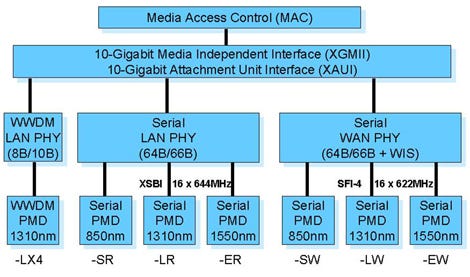 The two 64B/66B PCS physical layers are then connected to the Physical Media Dependent (PMD) layers through either XSBI (LAN) or SFI-4 (WAN). Next page: SFI-4 Based MSAsThe first two MSAs used for 10G Ethernet were primarily developed to support 10-Gig Sonet and DWDM applications. These are the 200-pin and 300-pin MSAs.Both MSAs support the OIF SFI-4 data interface. This interface has sixteen 622MHz serial interfaces that are muxed onto a single optical interface by the transponder.For 10-Gig Ethernet LAN applications, transponders must support the 10.3-Gbit/s optical data rate and support an XSBI data interface. XSBI is an extension to SPI-4, defined by the IEEE with the frequency of the 16 serial lines increased from 622MHz to 644MHz.200-Pin MSAThis is the specification for a small-footprint 10-Gig transponder with a 200-pin connector. Specifications are referenced for Sonet at various distances and 10-Gig Ethernet at the standard 300m, 10km, and 40km.The MSA was driven by Infineon Technologies AG (NYSE/Frankfurt: IFX), Intel Corp. (Nasdaq: INTC), and JDS Uniphase Corp. (Nasdaq: JDSU; Toronto: JDU) and publicly released in August 2000. There are full-production modules shipping from Multiplex Inc., Network Elements Inc., and OptronX Inc., and Cielo Communications Inc. has modules in development.300 Pin MSAThis is currently the MSA with the largest support. The specification is primarily for 10-Gig Sonet and DWDM applications, with several ranges defined for 1310nm and 1550nm transponders. The MSA defines a 300-pin connector and a I2C communications link for transponder management. Through the communications link, the MSA defines both MSA functions and proprietary functions. The same communications link will be used for a 300-pin, 40-Gbit/s MSA in definition."The advantage of the 300-pin MSA is that is has a very free form factor" says Gary Wiseman, Director of marketing with Intel.Driven by Agere Systems (NYSE: AGR), Alcatel SA (NYSE: ALA; Paris: CGEP:PA), and OpNext Inc., there are already production devices shipping from many companies. See the table at the end of the report for details.Next page: Xenpak MSAXenpak is probably the most important MSA for 10-Gig Ethernet. Xenpak is defined specifically for 10-Gig Ethernet transponders and is connected through the IEEE XAUI interface. The transponder must therefore include the 64B/66B PCS block (see figure 2).The XAUI interface is a 4-channel, 3.125-Gbit/s interface with 8B/10B encoding. XAUI extends the XGMII interface to 50cm and has a 70-way, 2-row connector.The management interface is a 2-wire interface with clock and data (MDC and MDIO). Through the management interface, you can:
The two 64B/66B PCS physical layers are then connected to the Physical Media Dependent (PMD) layers through either XSBI (LAN) or SFI-4 (WAN). Next page: SFI-4 Based MSAsThe first two MSAs used for 10G Ethernet were primarily developed to support 10-Gig Sonet and DWDM applications. These are the 200-pin and 300-pin MSAs.Both MSAs support the OIF SFI-4 data interface. This interface has sixteen 622MHz serial interfaces that are muxed onto a single optical interface by the transponder.For 10-Gig Ethernet LAN applications, transponders must support the 10.3-Gbit/s optical data rate and support an XSBI data interface. XSBI is an extension to SPI-4, defined by the IEEE with the frequency of the 16 serial lines increased from 622MHz to 644MHz.200-Pin MSAThis is the specification for a small-footprint 10-Gig transponder with a 200-pin connector. Specifications are referenced for Sonet at various distances and 10-Gig Ethernet at the standard 300m, 10km, and 40km.The MSA was driven by Infineon Technologies AG (NYSE/Frankfurt: IFX), Intel Corp. (Nasdaq: INTC), and JDS Uniphase Corp. (Nasdaq: JDSU; Toronto: JDU) and publicly released in August 2000. There are full-production modules shipping from Multiplex Inc., Network Elements Inc., and OptronX Inc., and Cielo Communications Inc. has modules in development.300 Pin MSAThis is currently the MSA with the largest support. The specification is primarily for 10-Gig Sonet and DWDM applications, with several ranges defined for 1310nm and 1550nm transponders. The MSA defines a 300-pin connector and a I2C communications link for transponder management. Through the communications link, the MSA defines both MSA functions and proprietary functions. The same communications link will be used for a 300-pin, 40-Gbit/s MSA in definition."The advantage of the 300-pin MSA is that is has a very free form factor" says Gary Wiseman, Director of marketing with Intel.Driven by Agere Systems (NYSE: AGR), Alcatel SA (NYSE: ALA; Paris: CGEP:PA), and OpNext Inc., there are already production devices shipping from many companies. See the table at the end of the report for details.Next page: Xenpak MSAXenpak is probably the most important MSA for 10-Gig Ethernet. Xenpak is defined specifically for 10-Gig Ethernet transponders and is connected through the IEEE XAUI interface. The transponder must therefore include the 64B/66B PCS block (see figure 2).The XAUI interface is a 4-channel, 3.125-Gbit/s interface with 8B/10B encoding. XAUI extends the XGMII interface to 50cm and has a 70-way, 2-row connector.The management interface is a 2-wire interface with clock and data (MDC and MDIO). Through the management interface, you can:Control Link status, speed, power down, fault, loopback
Obtain PMD capabilities (wavelength, loopback)
Access registers for WIS, PCS error counters, test patterns, status and control
 The MSA defines a "hot-pluggable" module that is 4.8in. x 1.4in. x 0.7in. This allows the user to plug the module in through the front panel without switching off the system. The hot-pluggable approach follows the trend with lower-speed Ethernet transponders and allows users to "pay as they go," with expensive transponder modules being added only as additional ports are required."We see the same thing happening in 10-GigE as happened in 1-GigE, which is the move to 'pluggable' modules" says Patrick Evaldsson, CEO and president at Optillion AB.Driven by Agere and Agilent Technologies Inc. (NYSE: A), with significant industry support, there are samples shipping now from eight companies, with several more about to enter volume production.Related articles in Light Reading:
The MSA defines a "hot-pluggable" module that is 4.8in. x 1.4in. x 0.7in. This allows the user to plug the module in through the front panel without switching off the system. The hot-pluggable approach follows the trend with lower-speed Ethernet transponders and allows users to "pay as they go," with expensive transponder modules being added only as additional ports are required."We see the same thing happening in 10-GigE as happened in 1-GigE, which is the move to 'pluggable' modules" says Patrick Evaldsson, CEO and president at Optillion AB.Driven by Agere and Agilent Technologies Inc. (NYSE: A), with significant industry support, there are samples shipping now from eight companies, with several more about to enter volume production.Related articles in Light Reading:Is Xenpak Past It?
Sweden Invades OFC
Sizing Up Xenpak
Blaze Hits the Xenpak Trail
Agilent Boosts 10 Gig Ethernet
Agilent, Agere Drive 10-Gig Ethernet
Next page: Other XAUI-Based MSAsXPAK MSAThis follow-up to Xenpak has been defined largely by Infineon, Intel, Picolight Inc. (see Trio Announce 10-Gig MSA). This MSA now has 20 or more companies signed up.
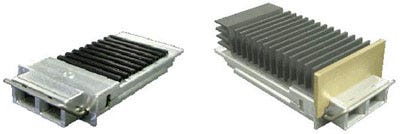 This is a hot-pluggable module the supports both XAUI and SFI-4 interfaces. It is defined to support 10-Gig Ethernet, OC192 and 10-Gig Fibre Channel up to 10km. The MSA supports low- and high-profile heat sinks for PCI and other applications.The modules are 40% smaller than Xenpak, supporting high-density rack-based systems and PCI cards. Both Infineon and Picolight have XPAK modules in development."We expect that XPAK will take over a lot of applications where you need the high volume. For example, enterprise applications up to 50km where you have simple serial 10-Gbit/s, including 10-Gig Ethernet or Fibre Channel," says Carsten Schwantes of Infineon Technologies.X2 MSAThe latest MSA is a direct competitor for XPAK. It also supports 10-Gig Ethernet, OC192, and 10-Gig Fibre Channel up to 10km. X2 supports XAUI and will support the OIF SFI-4.2 interfaces and serial electrical interfaces, as they emerge.
This is a hot-pluggable module the supports both XAUI and SFI-4 interfaces. It is defined to support 10-Gig Ethernet, OC192 and 10-Gig Fibre Channel up to 10km. The MSA supports low- and high-profile heat sinks for PCI and other applications.The modules are 40% smaller than Xenpak, supporting high-density rack-based systems and PCI cards. Both Infineon and Picolight have XPAK modules in development."We expect that XPAK will take over a lot of applications where you need the high volume. For example, enterprise applications up to 50km where you have simple serial 10-Gbit/s, including 10-Gig Ethernet or Fibre Channel," says Carsten Schwantes of Infineon Technologies.X2 MSAThe latest MSA is a direct competitor for XPAK. It also supports 10-Gig Ethernet, OC192, and 10-Gig Fibre Channel up to 10km. X2 supports XAUI and will support the OIF SFI-4.2 interfaces and serial electrical interfaces, as they emerge.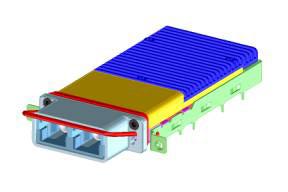 The hot-pluggable module is mounted on a rail system (see figure 4). As there is no cage around the module, the MSA can support various height modules. This allows modules with different heat sinks and therefore different thermal characteristics, depending on the application. The modules can be plugged in from rear of the system as well as from the front.As with Xenpak, the founders are Agere and Agilent, along with Mitsubishi Electric & Electronics USA Inc., Optillion, NEC Electronics Inc., OpNext, JDSU, and Tyco International Ltd. (NYSE: TYC; London: TYI) (see X2 MSA Launched). The first draft of the specification has been published, but it's too early to say what additional support this MSA will receive."X2 is building on Xenpak for second-generation applications, things like mid-level Ethernet switches, whereas Xenpak is more suitable for higher-end switches" says Anthony Spilman, strategic marketing manager at Agilent. Spilman goes on to say, "A big plus for X2 is that if a network equipment manufacturer has designed their switch for Xenpak, the connection for X2 is electrically compatible, and we’ve designed the mechanical and thermal characteristics so that companies that have designed with Xenpak can use that experience on a midrange switch for X2."Next page: XFP MSAFinally, we come to the XFP MSA. The XFP MSA really defines a transceiver rather than a transponder. The MSA defines a device supporting Sonet OC192, 10-Gig Ethernet and 10-Gig Fibre Channel, with a serial 10-Gbit/s electrical interface called XFI. This is the first electrical interface that has been defined within an MSA. The transceiver is hot-pluggable, with a very small footprint. The MSA defines 850nm, 1310nm, and 1550nm serial optical interfaces.
The hot-pluggable module is mounted on a rail system (see figure 4). As there is no cage around the module, the MSA can support various height modules. This allows modules with different heat sinks and therefore different thermal characteristics, depending on the application. The modules can be plugged in from rear of the system as well as from the front.As with Xenpak, the founders are Agere and Agilent, along with Mitsubishi Electric & Electronics USA Inc., Optillion, NEC Electronics Inc., OpNext, JDSU, and Tyco International Ltd. (NYSE: TYC; London: TYI) (see X2 MSA Launched). The first draft of the specification has been published, but it's too early to say what additional support this MSA will receive."X2 is building on Xenpak for second-generation applications, things like mid-level Ethernet switches, whereas Xenpak is more suitable for higher-end switches" says Anthony Spilman, strategic marketing manager at Agilent. Spilman goes on to say, "A big plus for X2 is that if a network equipment manufacturer has designed their switch for Xenpak, the connection for X2 is electrically compatible, and we’ve designed the mechanical and thermal characteristics so that companies that have designed with Xenpak can use that experience on a midrange switch for X2."Next page: XFP MSAFinally, we come to the XFP MSA. The XFP MSA really defines a transceiver rather than a transponder. The MSA defines a device supporting Sonet OC192, 10-Gig Ethernet and 10-Gig Fibre Channel, with a serial 10-Gbit/s electrical interface called XFI. This is the first electrical interface that has been defined within an MSA. The transceiver is hot-pluggable, with a very small footprint. The MSA defines 850nm, 1310nm, and 1550nm serial optical interfaces. 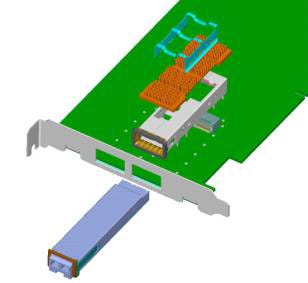 For XFP the heat sink is mounted on the cage, so the same transceiver module can be used in different applications (see figure 5). This MSA has wide industry support from the manufacturers of:
For XFP the heat sink is mounted on the cage, so the same transceiver module can be used in different applications (see figure 5). This MSA has wide industry support from the manufacturers of:Transponders
Semiconductors
Networking equipment
Storage systems
"XFP is tiny. It really is very small compared with the other 10-Gbit/s solutions on the market and enables 16 ports per blade," says Leland Day, manager of datacom strategy at JDS Uniphase.Next page: 10-GigE Transponder MSA SummarySo to summarize, 10-Gbit/s Ethernet transponders are becoming available from many different vendors, supporting various transponder MSAs:
200/300 pin for 10-Gig Ethernet, as well as Sonet and DWDM
Xenpak for 10-Gig Ethernet "hot-pluggable" transponders
XPAK or X2 for lower-power and lower-cost 10-Gig modules for 10km
XFP is likely to be the MSA for 10-Gig serial transceivers in the future
Next page: 10-GigE Transponder VendorsAgere Systems (NYSE: AGR)Agere is a big player in the transponder market but now looks as though it’ll be throwing in the towel, following last week’s announcement that it’s going to quit the optoelectronics market and focus on integrated circuits (see Lights Out for Agere's Opto Biz and Agere's Exit From Opto: Sad but Sensible).Agere started out as a network processor company, before being purchased by Lucent and then spun out, along with the rest of Lucent’s semiconductor business (see Lucent Completes Agere Spinoff). Agere Systems has been a leader in optical components and integrated circuits for communications networks. It was a founder of the 300-pin and Xenpak MSAs and is also a founder of the X2 MSA.Agere has a full range of 300-pin transponders covering 10-GigE LAN and WAN applications at both long and extended reach distances. Agere is sampling a 1310nm 10km Xenpak transponder and has announced a 1310nm Xenpak transponder that will support 40km. Agere develops its own PMD devices and considers its 1310nm uncooled laser technology a key advantage. Agere is working though IEEE to have 1310nm transponders supporting the 40km extended range included in the list of devices supported by the IEEE 802.3ae spec. Before its announcement to quit the opto business, Agere was also working on longer-range 1550nm devices.See OFC Is Highly Transponderant and Agilent, Agere Drive 10-Gig Ethernet .Agilent Technologies Inc. (NYSE: A)Optical technology is a major strength for Agilent, with a focus on high quality, good EMI performance, and low power. Agilent was a founder of the Xenpak MSA and is a founder of the X2 MSA. Agilent is sampling a 1310nm XENPAK transponder that is expected to enter production in October 2002. Agilent is also developing 1550nm technology.See Agilent Boosts 10 Gig Ethernet .Cielo Communications Inc.Cielo has announced a couple of 200-pin transponders supporting 10-GigE but have delayed sampling while they focus on other market areas.See Cielo Pushes the Limits on Lasers.Infineon Technologies AG (NYSE/Frankfurt: IFX)Infineon was spun out of Siemens and has a full range of networking devices and strong optical technology. Infineon was a founder of the 200-pin MSA and is a founder of XPAK. Infineon sees its 1310nm and 1550nm laser technology and the integration of its own physical layer devices as key advantages.“The MSA defines the number of pins and the optical specification, but we expect companies to differentiate based on the additional features,” says Carsten Schwantes. “For example, at Infineon we have very good diagnostics and BER testing, which we can do as we have our own PHY chips.”Infineon is sampling a 10km 1310nm Xenpak transponder and will start sampling a 1310nm XPAK transponder later this year.See Infineon Gets 10-Gig Boost.Intel Corp. (Nasdaq: INTC)Through the acquisition of LightLogic, Intel has a strong transponder technology. Intel was a founder of the 300-pin MSA and is a founder of the XPAK MSA.Intel has a full range of 300-pin transponders covering 10-GigE LAN and WAN applications at both long and extended reach distances. Intel is also sampling a 10km 1310nm Xenpak transponder. “The Xenpak part is gearing up for full production and has been designed into a number of systems,” says Gary Wiseman, director of marketing with Intel.See LightLogic Bulks Up Under Intel and Intel's 10-Gig Shopping Spree.JDS Uniphase Corp. (Nasdaq: JDSU; Toronto: JDU)In January 2002, JDS Uniphase completed the acquisition of IBM’s optical transceiver business. IBM was a founder of the 200-pin MSA and JDS Uniphase is a founder of the X2 and XFP MSAs. JDSU has a range of 300-pin transponders in production and is sampling a 10km 1310nm Xenpak transponder.See JDSU's Bid for the Enterprise.Mitsubishi Electric & Electronics USA Inc.Mitsubishi is a founder of the X2 MSA and has a 10km 1310nm Xenpak module sampling. Mitsubishi is also expecting to start sampling a 40km 1310nm Xenpak module in the fourth quarter of 2002.Multiplex Inc.Multiplex has a range of 200-pin and 300-pin transponders covering the long and extended range 10-Gig Ethernet distances.Network Elements Inc.Network Elements has packaged their 1310nm transponder in both 200-pin and 300-pin MSA devices and also has its "Lithium" MPM (Multi-Protocol Module). The LiMPM integrates the optical transmitter and receiver together with both OC192 Sonet and 10-Gig Ethernet physical layer and MAC functions. See 10-Gigabit Convergence at Hand.OpNext Inc.OpNext was spun off from Hitachi and was a founder of the 300-pin MSA. It is also a founder of the X2 MSA. Key advantages for OpNext are lower power and higher junction temperature. OpNext has a range of 300-pin transponders in production with both 1310nm and 1550nm Xenpak modules sampling.Optillion ABOptillion is a founder of the X2 MSA and has 1310nm Xenpak transponders for both 10km and 40km distances.“We have expertise in-house for optical components. We manufacture our own optical chips,” says Patrick Evaldsson, CEO and president of Optillion. “We believe this gives us a cost competitive advantage in the market.”See Sweden Invades OFC .Optium Corp.Founded by a bunch of ex-JDSU executives, Optium is a founder of the X2 MSA and has a range of 300-pin 1310nm and 1550nm transponders in production.See Kalkhoven Opts for Optium.OptronX Inc.OptronX has a large range of 200-pin and 300-pin transponders designed for Sonet applications that can also be used for 10-Gig Ethernet.Picolight Inc.Picolight has announced both 850nm and 1310nm transponders supporting XPAK. These transponders are in addition to earlier devices supporting their own form factor and the 300-pin MSA.Toshiba Corp.Toshiba has a range of 10-Gbit/s transceivers, but none currently support 10-Gig Ethernet.Vitesse Semiconductor Corp. (Nasdaq: VTSS)Vitesse got into the optoelectronic business when it purchased Versatile Optical Networks in 2001. Its first products, which emerged in March 2002, include a range of 300-pin 1550nm transponders supporting 10-Gig Ethernet as well Sonet and DWDM over 80km.See Vitesse Enters Optical.Next page: Product Table
Dynamic Table: 10-Gig Ethernet Transponders
Select fields:
Show All Fields
Company Device Status Power MSA 10.3GBaud XSBI XAUI IEEE 802.3ae Device Sonet DWDM Range Wavelength L (in.) W (in.) H (in.)
How to use the 10-Gigabit Ethernet transponder table:The main 10-GigE transponders are listed here. Where information is not disclosed or unknown, this is signified by "?". Where an entry is not relevant, this is shown by "-".Company: The transponder vendor.Device: The name or number of the transponder. In some cases, this is the name of a family of transponders.Status: Whether the device is sampling or in full production. Where details on the device have been announced ahead of samples, we give the quarter in which samples are expected to be available.Power: This is the dissipated power (maximum or typical) for the transponder.MSA: Which MSA this transponder is designed to meet. A couple of transponders are not designed to meet any of the MSA requirements but can be used for 10-Gig Ethernet.10.3GBaud: Does the transponder handle the 10.3GBaud line rate required for the 10GBASE-xR specifications?XSBI: Does the transponder support the 16x 644-Mbit/s XSBI interface defined by IEEE802.3ae?XAUI: Does the transponder support the IEEE XAUI interface?IEEE 802.3ae Device: Which IEEE 802.3ae device(s) does the transponder support? Some transponders support 10-Gig Ethernet at distances not included in the IEEE 802.3ae standard or with non-standard wavelengths.Sonet: Does the transponder support Sonet line rates?DWDM: Does the transponder support DWDM?Range: The range of the transponder.Wavelength: The laser wavelength.L (in.) W (in.) H (in.): The physical size of the transponder.
You May Also Like









